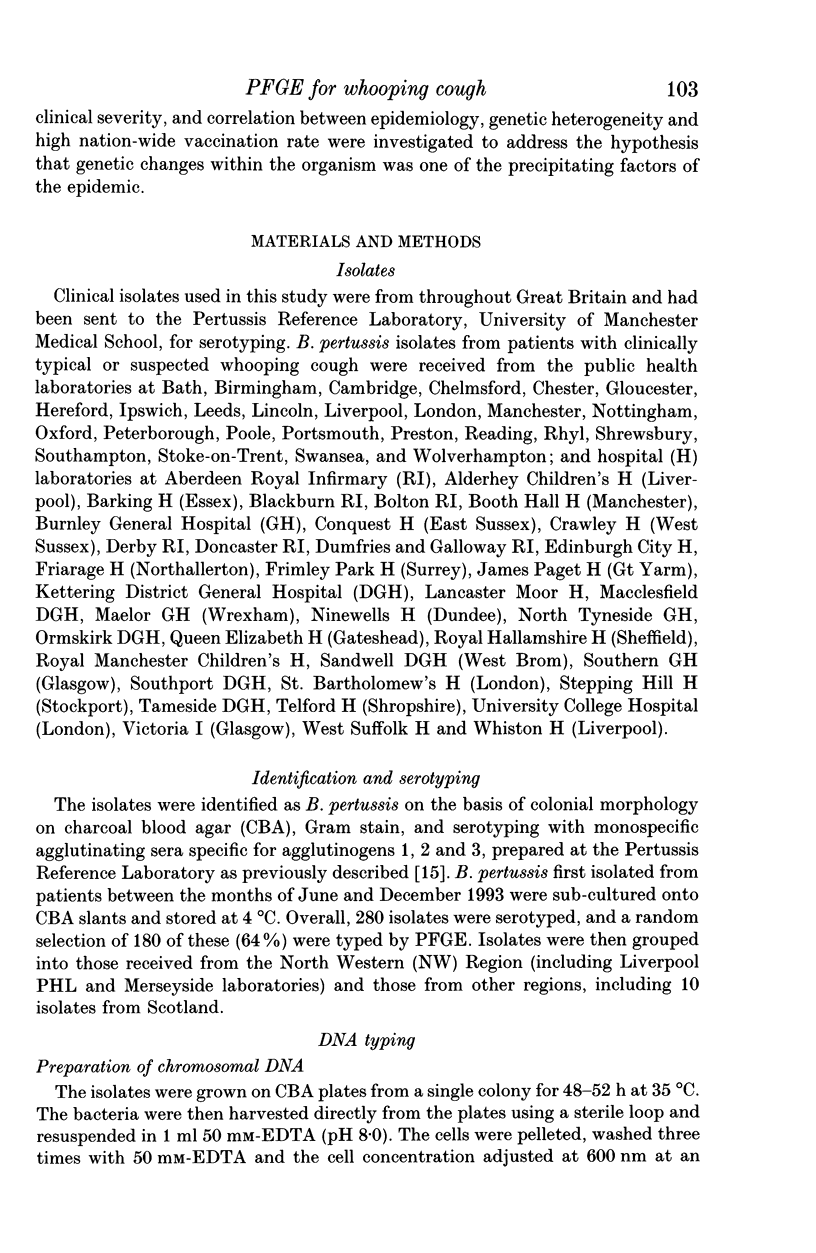Abstract
The purpose of this study was to DNA fingerprint the majority (64%) of isolates received at the Pertussis Reference Laboratory during the 1993 whooping cough epidemic by pulsed field gel electrophoresis of Xba I-generated restriction digests. Two DNA restriction patterns, types 1 and 3, predominated (40% and 23%, respectively, of 180 isolates) but type 2, identified in a previous study was notably absent. Twenty-one new DNA types occurred (24% of isolates), some being atypical as bands 155-230 kb were no longer conserved, but there was no statistically significant difference in their incidence in the upswing (June-September) compared to the downswing (October-December) phase of the epidemic. There was a relatively high proportion of new types, compared to type 1, at the peak (September). About 50% of isolates received were from the North Western Region, where 44% of isolates were DNA type 1. Whereas only 1 out of 10 isolates from Scotland were of this type, suggesting some geographic variation. Statistically significant findings included a higher proportion of isolates from female patients (P < 0.01), most marked in the 12-24 months age group (P < 0.05); a higher proportion of infants under 12 months requiring hospital admission compared to older children (P < 0.05); and a greater number of isolates from unvaccinated children (P < 0.01). Analysis of serotype according to four age groups (under 3 months, 3-12 months, 12-24 months and above 2 years) showed statistically significant differences (P < 0.05) with a noticeably lower proportion (38%) of serotype 1,3 in 3-12 months age group and higher prevalence (74%) of serotype 1,3 in the 12-24 months age group. There was no correlation between DNA type and serotype.
Full text
PDF












Images in this article
Selected References
These references are in PubMed. This may not be the complete list of references from this article.
- Booy R., Aitken S. J., Taylor S., Tudor-Williams G., Macfarlane J. A., Moxon E. R., Ashworth L. A., Mayon-White R. T., Griffiths H., Chapel H. M. Immunogenicity of combined diphtheria, tetanus, and pertussis vaccine given at 2, 3, and 4 months versus 3, 5, and 9 months of age. Lancet. 1992 Feb 29;339(8792):507–510. doi: 10.1016/0140-6736(92)90336-2. [DOI] [PubMed] [Google Scholar]
- Cantor C. R., Smith C. L., Mathew M. K. Pulsed-field gel electrophoresis of very large DNA molecules. Annu Rev Biophys Biophys Chem. 1988;17:287–304. doi: 10.1146/annurev.bb.17.060188.001443. [DOI] [PubMed] [Google Scholar]
- Fine P. E. Herd immunity: history, theory, practice. Epidemiol Rev. 1993;15(2):265–302. doi: 10.1093/oxfordjournals.epirev.a036121. [DOI] [PubMed] [Google Scholar]
- Finegold S. M. In memoriam: Vera La Verne Sutter. Rev Infect Dis. 1991 May-Jun;13(3):528–528. doi: 10.1093/clinids/13.3.528. [DOI] [PubMed] [Google Scholar]
- Galbraith N. S., Forbes P., Mayon-White R. T. Changing patterns of communicable disease in England and Wales. Part III--Increasing infectious diseases. Br Med J. 1980 Aug 23;281(6239):546–549. doi: 10.1136/bmj.281.6239.546. [DOI] [PMC free article] [PubMed] [Google Scholar]
- Khattak M. N., Matthews R. C., Burnie J. P. Is Bordetella pertussis clonal? BMJ. 1992 Mar 28;304(6830):813–815. doi: 10.1136/bmj.304.6830.813. [DOI] [PMC free article] [PubMed] [Google Scholar]
- Khattak M. N., Matthews R. C. Genetic relatedness of Bordetella species as determined by macrorestriction digests resolved by pulsed-field gel electrophoresis. Int J Syst Bacteriol. 1993 Oct;43(4):659–664. doi: 10.1099/00207713-43-4-659. [DOI] [PubMed] [Google Scholar]
- McClelland M., Jones R., Patel Y., Nelson M. Restriction endonucleases for pulsed field mapping of bacterial genomes. Nucleic Acids Res. 1987 Aug 11;15(15):5985–6005. doi: 10.1093/nar/15.15.5985. [DOI] [PMC free article] [PubMed] [Google Scholar]
- Miller E., Farrington C. P. The current epidemiology of pertussis in the developed world: UK and West Germany. Tokai J Exp Clin Med. 1988;13 (Suppl):97–101. [PubMed] [Google Scholar]
- Pollock T. M., Miller E., Lobb J. Severity of whooping cough in England before and after the decline in pertussis immunisation. Arch Dis Child. 1984 Feb;59(2):162–165. doi: 10.1136/adc.59.2.162. [DOI] [PMC free article] [PubMed] [Google Scholar]
- Preston N. W., Carter E. J. Serotype specificity of vaccine-induced immunity to pertussis. Commun Dis Rep CDR Rev. 1992 Dec 4;2(13):R155–R156. [PubMed] [Google Scholar]
- Preston N. W. Change in serotype of pertussis infection in Britain. Lancet. 1985 Mar 2;1(8427):510–510. doi: 10.1016/s0140-6736(85)92101-4. [DOI] [PubMed] [Google Scholar]
- Preston N. W. Technical problems in the laboratory diagnosis and prevention of whooping-cough. Lab Pract. 1970 May;19(5):482–486. [PubMed] [Google Scholar]
- Ramsay M. E., Corbel M. J., Redhead K., Ashworth L. A., Begg N. T. Persistence of antibody after accelerated immunisation with diphtheria/tetanus/pertussis vaccine. BMJ. 1991 Jun 22;302(6791):1489–1491. doi: 10.1136/bmj.302.6791.1489. [DOI] [PMC free article] [PubMed] [Google Scholar]
- Smith C. L., Cantor C. R. Purification, specific fragmentation, and separation of large DNA molecules. Methods Enzymol. 1987;155:449–467. doi: 10.1016/0076-6879(87)55030-3. [DOI] [PubMed] [Google Scholar]
- White J. M., Leon S., Begg N. T. 'COVER' (cover of vaccination evaluated rapidly): 27. Commun Dis Rep CDR Rev. 1993 Oct 8;3(11):R158–R158. [PubMed] [Google Scholar]



